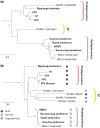Endogenous amdoparvovirus-related elements reveal insights into the biology and evolution of vertebrate parvoviruses
- PMID: 30443409
- PMCID: PMC6232428
- DOI: 10.1093/ve/vey026
Endogenous amdoparvovirus-related elements reveal insights into the biology and evolution of vertebrate parvoviruses
Abstract
Amdoparvoviruses (family Parvoviridae: genus Amdoparvovirus) infect carnivores, and are a major cause of morbidity and mortality in farmed animals. In this study, we systematically screened animal genomes to identify endogenous parvoviral elements (EPVs) disclosing a high degree of similarity to amdoparvoviruses, and investigated their genomic, phylogenetic and protein structural features. We report the first examples of full-length, amdoparvovirus-derived EPVs in the genome of the Transcaucasian mole vole (Ellobius lutescens). We also identify four EPVs in mammal and reptile genomes that are intermediate between amdoparvoviruses and their sister genus (Protoparvovirus) in terms of their phylogenetic placement and genomic features. In particular, we identify a genome-length EPV in the genome of a pit viper (Protobothrops mucrosquamatus) that is more similar to a protoparvovirus than an amdoparvovirus in terms of its phylogenetic placement and the structural features of its capsid protein (as revealed by homology modeling), yet exhibits characteristically amdoparvovirus-like genome features including: (1) a putative middle ORF gene; (2) a capsid gene that lacks a phospholipase A2 domain; (3) a genome structure consistent with an amdoparvovirus-like mechanism of capsid gene expression. Our findings indicate that amdoparvovirus host range extends to rodents, and that parvovirus lineages possessing a mixture of proto- and amdoparvovirus-like characteristics have circulated in the past. In addition, we show that EPV sequences in the mole vole and pit viper encode intact, expressible replicase genes that have potentially been co-opted or exapted in these host species.
Keywords: amdoparvovirus; endogenous virus; paleovirology; parvovirus; protoparvovirus.
Figures



Similar articles
-
A new perspective on the evolution and diversity of the genus Amdoparvovirus (family Parvoviridae) through genetic characterization, structural homology modeling, and phylogenetics.Virus Evol. 2022 Jun 17;8(1):veac056. doi: 10.1093/ve/veac056. eCollection 2022. Virus Evol. 2022. PMID: 35783582 Free PMC article.
-
Diverse amdoparvoviruses infection of farmed Asian badgers (Meles meles).Arch Virol. 2024 Jun 8;169(7):139. doi: 10.1007/s00705-024-06073-9. Arch Virol. 2024. PMID: 38849620
-
Full genetic characterization and epidemiology of a novel amdoparvovirus in striped skunk (Mephitis mephitis).Emerg Microbes Infect. 2017 May 10;6(5):e30. doi: 10.1038/emi.2017.13. Emerg Microbes Infect. 2017. PMID: 28487558 Free PMC article.
-
Amdoparvoviruses in small mammals: expanding our understanding of parvovirus diversity, distribution, and pathology.Front Microbiol. 2015 Oct 12;6:1119. doi: 10.3389/fmicb.2015.01119. eCollection 2015. Front Microbiol. 2015. PMID: 26528267 Free PMC article. Review.
-
Small but mighty: old and new parvoviruses of veterinary significance.Virol J. 2021 Oct 24;18(1):210. doi: 10.1186/s12985-021-01677-y. Virol J. 2021. PMID: 34689822 Free PMC article. Review.
Cited by
-
Evolution of dependoparvoviruses across geological timescales-implications for design of AAV-based gene therapy vectors.Virus Evol. 2020 May 22;6(2):veaa043. doi: 10.1093/ve/veaa043. eCollection 2020 Jul. Virus Evol. 2020. PMID: 32913662 Free PMC article.
-
Multi-host dispersal of known and novel carnivore amdoparvoviruses.Virus Evol. 2020 Dec 6;6(2):veaa072. doi: 10.1093/ve/veaa072. eCollection 2020 Jul. Virus Evol. 2020. PMID: 36158990 Free PMC article.
-
Natural disease and evolution of an Amdoparvovirus endemic in striped skunks (Mephitis mephitis).Transbound Emerg Dis. 2022 Sep;69(5):e1758-e1767. doi: 10.1111/tbed.14511. Epub 2022 Mar 26. Transbound Emerg Dis. 2022. PMID: 35279956 Free PMC article.
-
A new perspective on the evolution and diversity of the genus Amdoparvovirus (family Parvoviridae) through genetic characterization, structural homology modeling, and phylogenetics.Virus Evol. 2022 Jun 17;8(1):veac056. doi: 10.1093/ve/veac056. eCollection 2022. Virus Evol. 2022. PMID: 35783582 Free PMC article.
-
Ecology and Infection Dynamics of Multi-Host Amdoparvoviral and Protoparvoviral Carnivore Pathogens.Pathogens. 2020 Feb 15;9(2):124. doi: 10.3390/pathogens9020124. Pathogens. 2020. PMID: 32075256 Free PMC article.
References
Grants and funding
LinkOut - more resources
Full Text Sources
Miscellaneous

